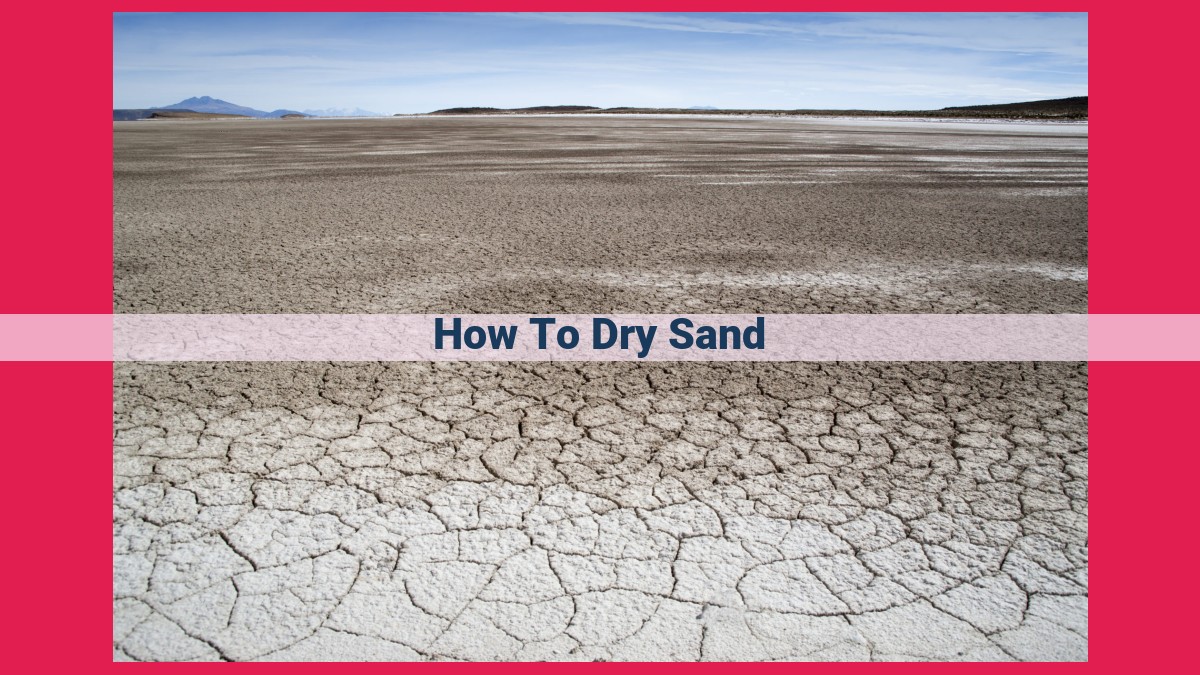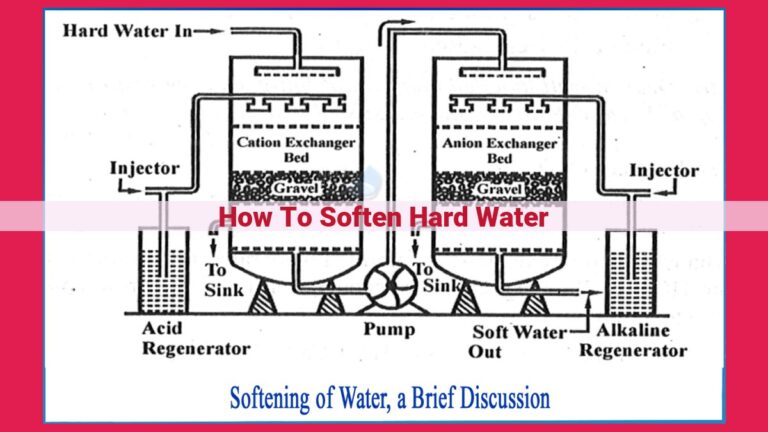Ultimate Guide To Drying Sand Quickly And Efficiently: Tips And Tricks

To dry sand efficiently, spread it thinly to increase surface area. Place in a well-ventilated area to allow air circulation and prevent mold. Regularly turn the sand to expose moist areas. Use a fan to increase air flow or a dehumidifier to remove moisture. Avoid overheating, as this can damage the sand.
How to Dry Wet Sand Quickly: Spread the Sand Thinly
Imagine you’re having a fun day at the beach, building sandcastles with your loved ones. Suddenly, a wave crashes over your masterpiece, leaving you with a soggy pile of sand. Don’t fret! Drying wet sand is easier than you might think, especially if you follow this crucial first step: spread the sand thinly.
When sand is spread thinly, it maximizes its surface area, which allows for more moisture to evaporate into the air. This accelerates the drying process significantly compared to leaving the sand in a thick pile.
Why does surface area matter? Imagine a blanket soaked in water. If you fold it up into a tight ball, only a small portion of the blanket is exposed to the air. Consequently, it will take much longer to dry. On the other hand, if you spread the blanket out flat, a much larger surface area is exposed, allowing the water to evaporate more quickly. The same principle applies to sand.
Here’s a simple analogy to illustrate the impact of surface area. If you have a glass of water, it will evaporate slowly because it has a relatively small surface area. However, if you pour the water into a shallow dish, it will evaporate much faster because the surface area is significantly increased.
Therefore, when drying sand, remember the golden rule: spread it thinly to maximize surface area and speed up the drying process.
The Key to Drying Sand: Ensuring Adequate Ventilation
When it comes to drying sand, ventilation is of paramount importance. Adequate air circulation is the driving force behind moisture evaporation, ensuring that your sand dries quickly and efficiently.
Without proper ventilation, moisture gets trapped, creating a breeding ground for mold and mildew. This not only slows down the drying process but also poses health risks. Mold spores can cause respiratory problems, allergies, and even structural damage to your home.
To promote air circulation, choose a drying location that is well-ventilated. Open windows and doors to allow cross-ventilation. If possible, set up fans to circulate the air around the sand, further accelerating the drying process. By providing ample airflow, you create an environment that is conducive to moisture evaporation and prevents the growth of harmful microorganisms.
Remember, a well-ventilated drying area is crucial for drying sand quickly and safely. By ensuring that air can freely circulate, you can expedite the drying process and avoid the unpleasant consequences of mold growth.
Turn the Sand Over Occasionally: A Crucial Step for Speedy Drying
In the arduous task of drying sand, it’s crucial to spread it thinly, place it in a well-ventilated area, and circulate air with a fan or dehumidifier. However, an often-overlooked step that plays a pivotal role in accelerating the process is turning the sand over occasionally.
Just as turning a roast in the oven ensures even cooking, turning the sand regularly exposes moist areas to the air, allowing them to dry more efficiently. This prevents pockets of moisture from persisting, which can lead to uneven drying and hinder the overall process.
Moreover, turning the sand encourages uniform evaporation, ensuring that all parts of the sand dry at a consistent rate. This reduces the likelihood of mold or bacteria growth, which can thrive in damp environments.
The frequency with which you turn the sand depends on several factors, such as the thickness of the spread, the temperature, and the humidity. A good rule of thumb is to turn the sand over every few hours, or more frequently if the sand is particularly wet or the air is humid.
To ensure proper turning, use a shovel or other tool to gently lift and invert the sand. Avoid stirring it vigorously, as this can break down the sand particles and create dust.
By turning the sand over regularly, you can significantly reduce the drying time and ensure that your sand is completely dry and ready to use in no time.
Harness the Power of Air Circulation: Using a Fan to Expedite Sand Drying
When it comes to drying sand, time is of the essence. But what if there was a way to significantly reduce the drying process, freeing up valuable time for your other projects?
Enter the humble fan, an unsung hero in the sand drying game. By increasing air flow, a fan creates an environment that encourages rapid evaporation, leading to a dramatic decrease in drying time.
As moist sand is exposed to a constant stream of air, water molecules gradually escape into the atmosphere. The fan’s unrelenting breeze helps to disperse moisture, creating a drier surface that allows deeper layers of sand to dry out more quickly.
For optimal results, position the fan in a way that maximizes air circulation. Place the sand in a well-ventilated area and point the fan directly at it. By circulating the air, the fan breaks up stagnant pockets of moisture, allowing fresh air to reach all parts of the sand.
Tips for Using a Fan to Dry Sand:
- Spread the sand thinly to increase surface area and promote evaporation.
- Turn the sand occasionally to expose moist areas and ensure even drying.
- Avoid overheating the sand by monitoring the temperature and keeping it well below excessive heat sources.
By harnessing the power of air circulation with a fan, you can dramatically reduce sand drying time.
Drying Sand with a Dehumidifier: A Solution for Quick and Efficient Results
Sand, a versatile material used in various applications, often requires drying to remove excess moisture for optimal use. While traditional methods like spreading thinly or using a fan can take a significant amount of time, employing a dehumidifier offers a rapid and effective solution.
A dehumidifier, a device designed to remove moisture from the air, creates a drier environment that significantly reduces the drying time of sand. Dehumidifiers work by absorbing moist air, condensing the water vapor into a collection tank, and releasing dry air back into the space.
In the context of drying sand, a dehumidifier extracts moisture from the air surrounding the sand, creating a lower humidity level. The drier air absorbs moisture from the sand, accelerating the evaporation process and drastically shortening the drying time.
Using a dehumidifier for sand drying offers several key advantages:
- Faster Drying: The ability to remove moisture from the air significantly speeds up the drying process, resulting in dry sand in a shorter amount of time.
- Improved Efficiency: Dehumidifiers maximize the efficiency of drying by creating an optimal environment for moisture evaporation, reducing the need for additional effort or energy.
- Reduced Risk of Mold: A drier environment prevents the growth of mold and bacteria, which can occur in moist sand and compromise its quality.
- Versatility: Dehumidifiers can be used to dry sand for various purposes, including construction, play areas, and soil amendment.
When using a dehumidifier to dry sand, it’s essential to ensure proper ventilation and airflow to facilitate air circulation and promote uniform drying. Additionally, monitoring the temperature and avoiding excessive heat is crucial to prevent damage to the sand and maintain its properties.
Don’t Overcook Your Sand: The Dangers of Excessive Heat
When it comes to drying sand, one common mistake is overheating it. Exposing sand to excessive heat can not only damage its properties but also render it unusable.
Sand is composed of tiny mineral particles, and when subjected to high temperatures, these particles can undergo irreversible changes. Overheating can cause sand to lose its original color, texture, and even its ability to hold water. In extreme cases, it can even become brittle and crumble.
To avoid these disastrous consequences, it’s crucial to monitor the temperature of the sand while drying it. Keep it within a moderate range to ensure that its integrity is preserved. Additionally, avoid placing the sand near excessive heat sources such as stoves, ovens, or direct sunlight.
By following these precautions, you can safely and effectively dry your sand without compromising its quality. Remember, the key is to let it dry gradually in a well-ventilated area, not to overheat it and potentially ruin it.





